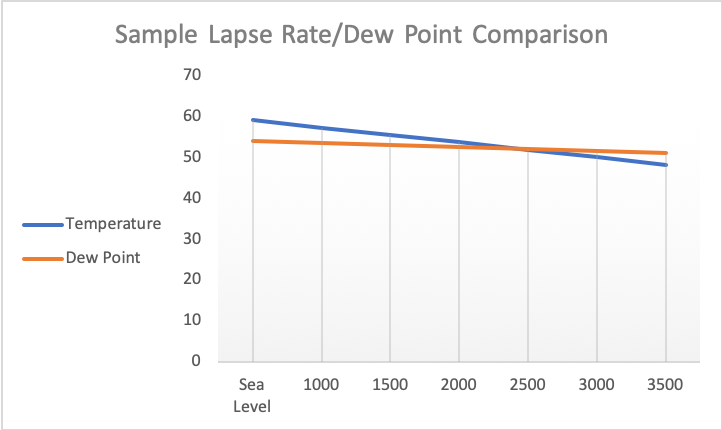Lapse Rate
Lapse Rate is the decrease of an atmospheric variable with height. In most cases, temperature is the variable the term is applied to.
For our purposes, Lapse Rate may be defined as rate of temperature change with height, and is expressed officially as °C km-1. For simplicity sake, we will also use °F/1000′
Lapse Rate may be used to indicate either the environmental lapse rate or the process lapse rate, both of which are discussed below.
Standard Atmosphere
The Standard Atmosphere is a “hypothetical average” pressure, temperature and air density for various altitudes.
The “U.S. Standard Atmosphere 1976″ is the most recent model used. Items of interest to a sailor include a standard temperature of 59° F (15° C) and barometric pressure of 1013.25 mb at the sea level, as well as a lapse rate of 3.56°F /1,000 ft from sea level to 36,090 feet.
Dry Lapse Rate
Also known as dry-adiabatic process, it is the lapse rate when assuming an atmosphere in which hypothetically no moisture is present.
Moist Lapse Rate
Also known as saturation-adiabatic process, it is the lapse rate when assuming an atmosphere which is fully saturated with moisture, and may contain liquid water.
Environmental Lapse Rate
The environmental lapse rate (ELR), is the rate of decrease of temperature with altitude in the stationary atmosphere at a given time and location. The actual ELR varies, however, if not known, the Standard Atmosphere lapse rate may be used.
A simple way to look at ELR is that it is the actual lapse rate occurring at a certain time and location.
ELR is measured using weather balloons launched two times a day from nearly 900 locations around the world. Recent weather balloon data can be found on the NOAA Storm Prediction Center website at https://www.spc.noaa.gov/exper/soundings/, or the University of Wyoming Department of Atmospheric Science website at http://weather.uwyo.edu/upperair/sounding.html
Process Lapse Rate
The lapse rate of a parcel of air moving up in the atmosphere may be different than the lapse rate of the surrounding air. Process lapse rate is the rate of decrease of the temperature of a specific air parcel as it is lifted.
Pressure, Temperature, and Condensation
Some points to remember:
- Warm air rises
- Air under decreasing pressure cools
- When the temperature of the air cools past the dew point condensation takes place
- Condensation releases heat
Dew Point
The dew point is the temperature the air needs to be cooled to (at constant pressure) in order to achieve a relative humidity of 100%. At this point the air cannot hold more water in the gas form. If the air were to be cooled even more, water vapor would have to come out of the atmosphere in the liquid form, usually as fog or precipitation.
Dew Point Lapse Rate
The dew point does not stay constant at increasing elevations. The dew point also has a lapse rate, in the vicinity of 1° F/ 1000 ft.
Lapse Rate Table
| Standard Atmosphere | -6.5° C/ km | -3.6° F / 1000 ft |
| Dry Lapse Rate | -9.8° C/ km | -5.4°F / 1000 ft |
| Moist Lapse Rate* | -5.8° C/ km | -3.2°F / 1000 ft |
| Dew Point Lapse Rate | -1.8° C/ km | -1°F / 1000 ft |
Minus signs have been added to the lapse rate values in this table to confirm that temperature decreases as altitude increases.
Where does this all take me?
As you can see, there is a lot of theory in lapse rates. Dry lapse rate is essentially stable.. Moist lapse rate varies with conditions. The Standard Atmosphere Lapse Rate is pretty much “the average to use.” Here’s why it’s important.

In this example, we use the standard lapse rate of 3.6° and a dew point lapse rate of 1°.
The temperature at sea level is 59° with a dew point of 54°when the parcel of air begins to lift. As the elevation increases the dew point begins to drop by about 1° for each 1000 ft of elevation increase.
The temperature of the parcel lowers more quickly than the dew point.
Using 3.6° for each 1000 ft the temperature of the air parcel and the dew point within the parcel will equalize at about 2500 feet, resulting in condensation of the water vapor in the parcel.
2500 feet is the point a visible cloud forms.
